苏州科技学院人文学院汉语专业社会语言学复习资料
- 格式:doc
- 大小:45.50 KB
- 文档页数:11
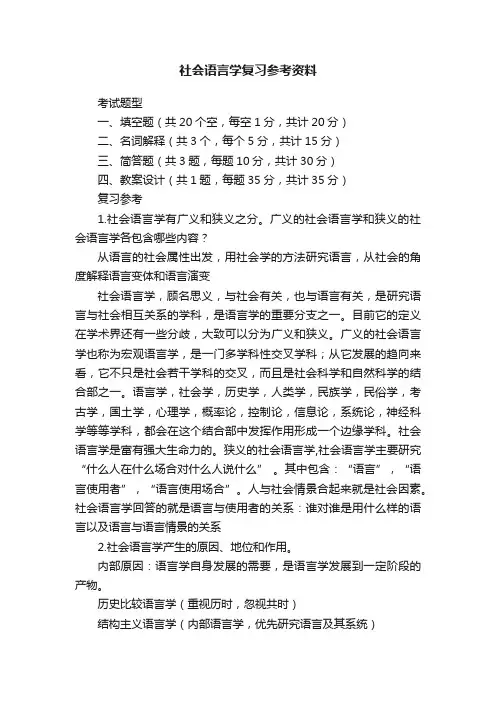
社会语言学复习参考资料考试题型一、填空题(共20个空,每空1分,共计20分)二、名词解释(共3个,每个5分,共计15分)三、简答题(共3题,每题10分,共计30分)四、教案设计(共1题,每题35分,共计35分)复习参考1.社会语言学有广义和狭义之分。
广义的社会语言学和狭义的社会语言学各包含哪些内容?从语言的社会属性出发,用社会学的方法研究语言,从社会的角度解释语言变体和语言演变社会语言学,顾名思义,与社会有关,也与语言有关,是研究语言与社会相互关系的学科,是语言学的重要分支之一。
目前它的定义在学术界还有一些分歧,大致可以分为广义和狭义。
广义的社会语言学也称为宏观语言学,是一门多学科性交叉学科;从它发展的趋向来看,它不只是社会若干学科的交叉,而且是社会科学和自然科学的结合部之一。
语言学,社会学,历史学,人类学,民族学,民俗学,考古学,国土学,心理学,概率论,控制论,信息论,系统论,神经科学等等学科,都会在这个结合部中发挥作用形成一个边缘学科。
社会语言学是富有强大生命力的。
狭义的社会语言学,社会语言学主要研究“什么人在什么场合对什么人说什么” 。
其中包含:“语言”,“语言使用者”,“语言使用场合”。
人与社会情景合起来就是社会因素。
社会语言学回答的就是语言与使用者的关系:谁对谁是用什么样的语言以及语言与语言情景的关系2.社会语言学产生的原因、地位和作用。
内部原因:语言学自身发展的需要,是语言学发展到一定阶段的产物。
历史比较语言学(重视历时,忽视共时)结构主义语言学(内部语言学,优先研究语言及其系统)转换生成语法学(倡导语言的“同一性” ,强调的是天生的语言能力)社会语言学(外部语言学,优先研究言语,强调的是交际能力,是后天获得的)外部原因:社会历史的一些亟待解决的问题:在美国主要是城市的政治和文化教育问题。
全球人口大流动使语言问题变得复杂。
科技发展及相关学科都在关注语言和社会的关系。
地位与作用:20世纪70年代以后,社会语言学的应用研究逐渐加强,到了20世纪80年代中期,社会语言学家特鲁杰明确提出了“应用社会语言学”这一概念。
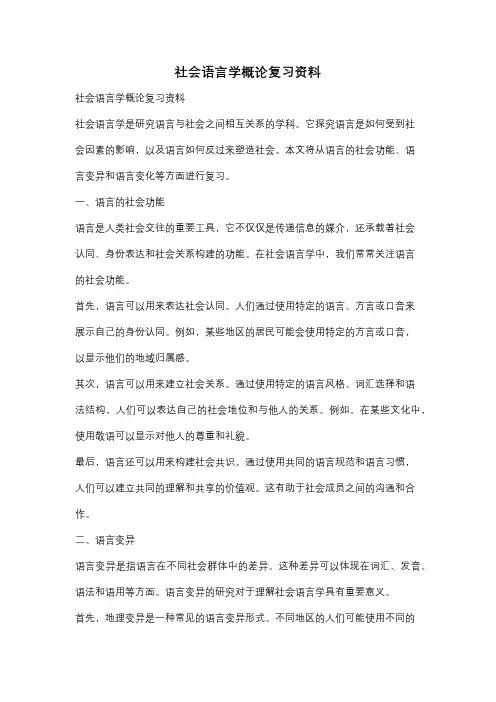
社会语言学概论复习资料社会语言学概论复习资料社会语言学是研究语言与社会之间相互关系的学科。
它探究语言是如何受到社会因素的影响,以及语言如何反过来塑造社会。
本文将从语言的社会功能、语言变异和语言变化等方面进行复习。
一、语言的社会功能语言是人类社会交往的重要工具,它不仅仅是传递信息的媒介,还承载着社会认同、身份表达和社会关系构建的功能。
在社会语言学中,我们常常关注语言的社会功能。
首先,语言可以用来表达社会认同。
人们通过使用特定的语言、方言或口音来展示自己的身份认同。
例如,某些地区的居民可能会使用特定的方言或口音,以显示他们的地域归属感。
其次,语言可以用来建立社会关系。
通过使用特定的语言风格、词汇选择和语法结构,人们可以表达自己的社会地位和与他人的关系。
例如,在某些文化中,使用敬语可以显示对他人的尊重和礼貌。
最后,语言还可以用来构建社会共识。
通过使用共同的语言规范和语言习惯,人们可以建立共同的理解和共享的价值观。
这有助于社会成员之间的沟通和合作。
二、语言变异语言变异是指语言在不同社会群体中的差异。
这种差异可以体现在词汇、发音、语法和语用等方面。
语言变异的研究对于理解社会语言学具有重要意义。
首先,地理变异是一种常见的语言变异形式。
不同地区的人们可能使用不同的方言或口音。
例如,中国的南方和北方人们在词汇、发音和语法上存在明显的差异。
其次,社会变异是另一种重要的语言变异形式。
社会变异指的是不同社会群体之间的语言差异。
这种差异可能与年龄、性别、职业、教育水平等社会因素有关。
例如,不同年龄段的人可能在词汇选择和语法结构上存在差异。
最后,语用变异是指语言在不同社交场景中的差异。
人们在不同的社交环境中使用不同的语言风格和语言策略。
例如,在正式场合中使用正式语言,而在非正式场合中使用非正式语言。
三、语言变化语言是一个动态的系统,不断发展和变化。
语言变化是指语言在时间上的演变和发展。
社会语言学关注语言变化的原因和过程。
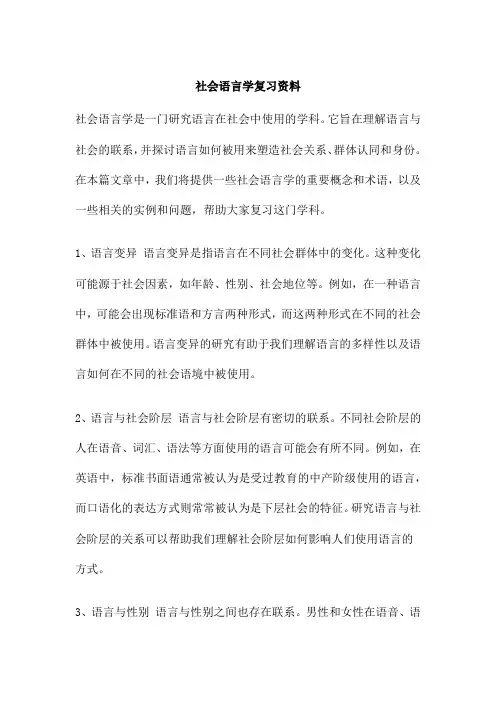
社会语言学复习资料社会语言学是一门研究语言在社会中使用的学科。
它旨在理解语言与社会的联系,并探讨语言如何被用来塑造社会关系、群体认同和身份。
在本篇文章中,我们将提供一些社会语言学的重要概念和术语,以及一些相关的实例和问题,帮助大家复习这门学科。
1、语言变异语言变异是指语言在不同社会群体中的变化。
这种变化可能源于社会因素,如年龄、性别、社会地位等。
例如,在一种语言中,可能会出现标准语和方言两种形式,而这两种形式在不同的社会群体中被使用。
语言变异的研究有助于我们理解语言的多样性以及语言如何在不同的社会语境中被使用。
2、语言与社会阶层语言与社会阶层有密切的联系。
不同社会阶层的人在语音、词汇、语法等方面使用的语言可能会有所不同。
例如,在英语中,标准书面语通常被认为是受过教育的中产阶级使用的语言,而口语化的表达方式则常常被认为是下层社会的特征。
研究语言与社会阶层的关系可以帮助我们理解社会阶层如何影响人们使用语言的方式。
3、语言与性别语言与性别之间也存在联系。
男性和女性在语音、语法和词汇方面使用的语言可能会有所不同。
例如,在某些语言中,女性通常使用更为礼貌和正式的语调,而男性则更倾向于使用粗鲁和直接的言语。
研究语言与性别之间的关系可以帮助我们理解性别如何影响人们使用语言的方式。
4、语言接触语言接触是指不同语言或方言之间的接触和交流。
这种交流可能会导致一种语言的词汇、语法和表达方式被另一种语言吸收或改变。
例如,在多元文化的城市中,可能会存在英语和汉语的混合使用,这种混合使用在日常生活中很常见。
研究语言接触可以帮助我们理解语言的融合和变化过程。
5、语言死亡语言死亡是指一种语言在社会中不再被使用或传承。
这通常是由于社会、政治和经济因素的影响。
例如,殖民统治和全球化可能会导致一种语言的消亡。
研究语言死亡可以帮助我们理解语言的演变和社会变革之间的关系。
总之,社会语言学是一门非常有趣的学科,它涉及到语言和社会之间的多个方面。
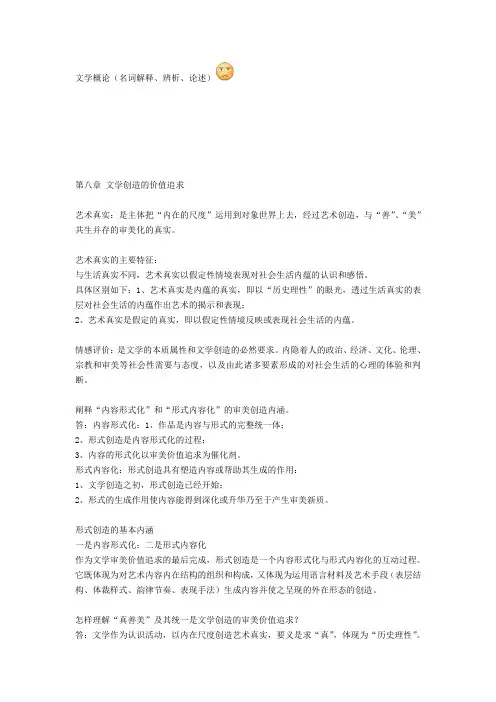
文学概论(名词解释、辨析、论述)第八章文学创造的价值追求艺术真实:是主体把“内在的尺度”运用到对象世界上去,经过艺术创造,与“善”、“美”共生并存的审美化的真实。
艺术真实的主要特征:与生活真实不同,艺术真实以假定性情境表现对社会生活内蕴的认识和感悟。
具体区别如下:1、艺术真实是内蕴的真实,即以“历史理性”的眼光,透过生活真实的表层对社会生活的内蕴作出艺术的揭示和表现;2、艺术真实是假定的真实,即以假定性情境反映或表现社会生活的内蕴。
情感评价:是文学的本质属性和文学创造的必然要求。
内隐着人的政治、经济、文化、伦理、宗教和审美等社会性需要与态度,以及由此诸多要素形成的对社会生活的心理的体验和判断。
阐释“内容形式化”和“形式内容化”的审美创造内涵。
答:内容形式化:1、作品是内容与形式的完整统一体;2、形式创造是内容形式化的过程;3、内容的形式化以审美价值追求为催化剂。
形式内容化:形式创造具有塑造内容或帮助其生成的作用:1、文学创造之初,形式创造已经开始;2、形式的生成作用使内容能得到深化或升华乃至于产生审美新质。
形式创造的基本内涵一是内容形式化;二是形式内容化作为文学审美价值追求的最后完成,形式创造是一个内容形式化与形式内容化的互动过程。
它既体现为对艺术内容内在结构的组织和构成,又体现为运用语言材料及艺术手段(表层结构、体裁样式、韵律节奏、表现手法)生成内容并使之呈现的外在形态的创造。
怎样理解“真善美”及其统一是文学创造的审美价值追求?答:文学作为认识活动,以内在尺度创造艺术真实,要义是求“真”,体现为“历史理性”。
作为审美活动,文学创作情感地评价对象,核心是尚“善”,体现为“人文关怀”。
最终,文学创造还要按照美的规律进行形式创造,为情感评价所把握的艺术真实“造形”,使之成为艺术文本,境界是呈“美”,体现为“文体升华”。
质而言之,真、善、美即文学创造的价值追求。
第九章文学作品的类型和体裁文学作品的类型:现实型文学(再现性、逼真性)象征型文学(暗示性、朦胧性)文学作品的基本体裁:诗:一种语词凝练、结构跳跃、富有节奏和韵律、高度集中地反映生活和抒发思想感情的文学体裁。

《社会语言学》复习大纲一、绪论
⒈社会语言学的定义
⒉语言和社会的关系
⒊社会语言学的分类
4. 社会语言学研究的课题。
二、语言和社会集团
⒈语言变体的定义
纽约市百货公司(r)的社会分层
伯恩斯坦提出的复杂代码和局限代码理论女国音
言语社区
2、语言的功能变体——语域和语体
三、语言的接触和相互影响
1. 双语或多语现象
国家双语
是否为现代社会的特点?及原因
2、语言的混合和融合
语言态度:变语配对
外来词
洋泾浜语
语码转换
四、言语交际
⒈言语交际的过程及原则
合作原则
⒉社会交际用语之称谓语
近年来称谓的变化
缺位
五、语言规划
⒈语言规划的定义、必要性、特点及其意义。
⒉语文规划的类别。
⒊语言规划的步骤。
⒋我国语文规划的情况。
六、语言与文化之禁忌语与委婉语
东西方区别
可变性
七、当代中文危机。

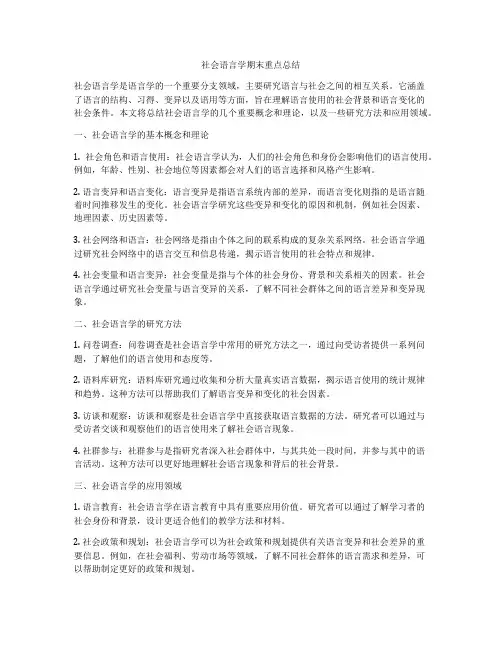
社会语言学期末重点总结社会语言学是语言学的一个重要分支领域,主要研究语言与社会之间的相互关系。
它涵盖了语言的结构、习得、变异以及语用等方面,旨在理解语言使用的社会背景和语言变化的社会条件。
本文将总结社会语言学的几个重要概念和理论,以及一些研究方法和应用领域。
一、社会语言学的基本概念和理论1. 社会角色和语言使用:社会语言学认为,人们的社会角色和身份会影响他们的语言使用。
例如,年龄、性别、社会地位等因素都会对人们的语言选择和风格产生影响。
2. 语言变异和语言变化:语言变异是指语言系统内部的差异,而语言变化则指的是语言随着时间推移发生的变化。
社会语言学研究这些变异和变化的原因和机制,例如社会因素、地理因素、历史因素等。
3. 社会网络和语言:社会网络是指由个体之间的联系构成的复杂关系网络。
社会语言学通过研究社会网络中的语言交互和信息传递,揭示语言使用的社会特点和规律。
4. 社会变量和语言变异:社会变量是指与个体的社会身份、背景和关系相关的因素。
社会语言学通过研究社会变量与语言变异的关系,了解不同社会群体之间的语言差异和变异现象。
二、社会语言学的研究方法1. 问卷调查:问卷调查是社会语言学中常用的研究方法之一,通过向受访者提供一系列问题,了解他们的语言使用和态度等。
2. 语料库研究:语料库研究通过收集和分析大量真实语言数据,揭示语言使用的统计规律和趋势。
这种方法可以帮助我们了解语言变异和变化的社会因素。
3. 访谈和观察:访谈和观察是社会语言学中直接获取语言数据的方法。
研究者可以通过与受访者交谈和观察他们的语言使用来了解社会语言现象。
4. 社群参与:社群参与是指研究者深入社会群体中,与其共处一段时间,并参与其中的语言活动。
这种方法可以更好地理解社会语言现象和背后的社会背景。
三、社会语言学的应用领域1. 语言教育:社会语言学在语言教育中具有重要应用价值。
研究者可以通过了解学习者的社会身份和背景,设计更适合他们的教学方法和材料。
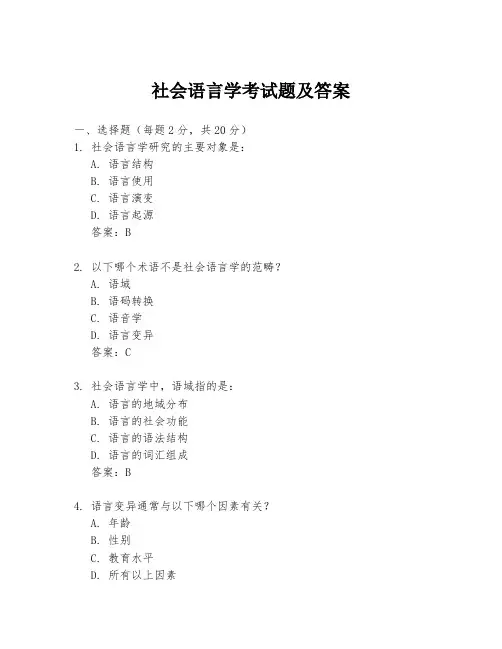
社会语言学考试题及答案一、选择题(每题2分,共20分)1. 社会语言学研究的主要对象是:A. 语言结构B. 语言使用C. 语言演变D. 语言起源答案:B2. 以下哪个术语不是社会语言学的范畴?A. 语域B. 语码转换C. 语音学D. 语言变异答案:C3. 社会语言学中,语域指的是:A. 语言的地域分布B. 语言的社会功能C. 语言的语法结构D. 语言的词汇组成答案:B4. 语言变异通常与以下哪个因素有关?A. 年龄B. 性别C. 教育水平D. 所有以上因素答案:D5. 语码转换是指:A. 语言的转换B. 语言的混合C. 语言的借用D. 语言的替换答案:B6. 在社会语言学中,性别差异对语言使用的影响主要表现在:A. 发音B. 词汇C. 语法D. 以上都是答案:D7. 以下哪个选项不是社会语言学研究的方法?A. 问卷调查B. 观察法C. 实验法D. 计算法答案:D8. 社会语言学研究中,社会阶层对语言的影响主要体现在:A. 语言的发音B. 语言的词汇C. 语言的语法D. 语言的风格答案:D9. 以下哪个术语与社会语言学无关?A. 社会方言B. 地域方言C. 语言接触D. 语言习得答案:D10. 社会语言学研究的主要目的是:A. 描述语言现象B. 解释语言现象C. 预测语言现象D. 以上都是答案:D二、简答题(每题5分,共20分)1. 简述社会语言学的定义。
答案:社会语言学是研究语言与社会之间关系的一个语言学分支,它探讨语言如何反映和影响社会结构、文化和社会身份。
2. 描述社会语言学中的“语码转换”现象。
答案:语码转换是指在不同的社会情境或与不同的社会群体交流时,人们会根据需要在不同语言或方言之间进行切换。
3. 社会语言学研究中,如何理解“语言变异”?答案:语言变异是指在不同的社会群体中,由于社会、文化、地域等因素影响,语言的发音、词汇、语法等方面表现出的差异。
4. 社会语言学研究有哪些主要方法?答案:社会语言学研究的主要方法包括问卷调查、观察法、访谈、语料库分析等。
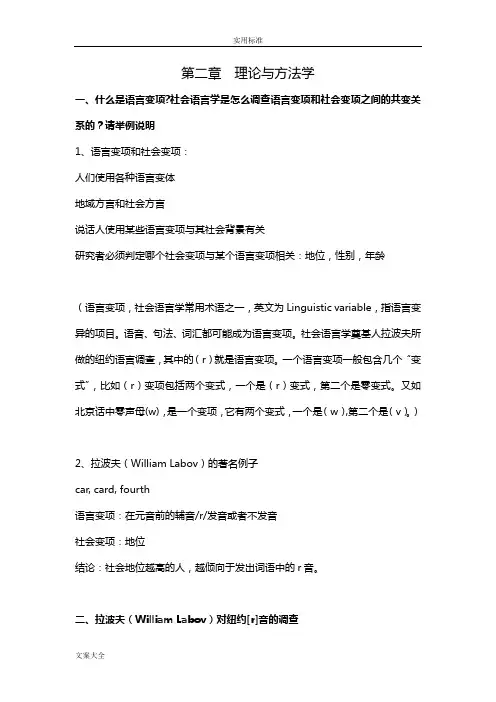
第二章理论与方法学一、什么是语言变项?社会语言学是怎么调查语言变项和社会变项之间的共变关系的?请举例说明1、语言变项和社会变项:人们使用各种语言变体地域方言和社会方言说话人使用某些语言变项与其社会背景有关研究者必须判定哪个社会变项与某个语言变项相关:地位,性别,年龄(语言变项,社会语言学常用术语之一,英文为Linguistic variable,指语言变异的项目。
语音、句法、词汇都可能成为语言变项。
社会语言学奠基人拉波夫所做的纽约语言调查,其中的(r)就是语言变项。
一个语言变项一般包含几个“变式”,比如(r)变项包括两个变式,一个是(r)变式,第二个是零变式。
又如北京话中零声母(w),是一个变项,它有两个变式,一个是(w),第二个是(v)。
)2、拉波夫(William Labov)的著名例子car, card, fourth语言变项:在元音前的辅音/r/发音或者不发音社会变项:地位结论:社会地位越高的人,越倾向于发出词语中的r音。
二、拉波夫(William Labov)对纽约[r]音的调查拉波夫:探索语言变异的个别理论纽约流行的r音假设:假如纽约市本地人中有任何两个集团在社会分层的阶梯上处于高低不同的地位,那么他们在发[r]音上也会表现出相应的差异。
假设被证实:越是社会地位高的人,或越是正规的场合,就会有越高的卷舌率语言变项:发r音/不发r音,w/v ,公交车/巴士语言变项可选择音位、词素、句法、词语等各层次上的某个结构单位语言变项的独特之处在于它同相应的社会变项发生有意义的共变。
60年代前半期拉波夫运用定量分析法研究语言变量与社会变量之间的关系拉波夫感觉到下层黑人倾向不发[r]音做出假设:假如纽约市本地人中两个集团处于不同的社会阶层,那么他们在发[r]音上也会表现出相应的差异。
怎样证实这个假设呢?怎么引导被试在自然状态下发出[r]音呢?1.确认这个商店第四层楼有什么商品(例如,女士鞋子)2.走进商店,向店员询问:“Excuse me, where are the women’s shoes?”3.店员会回答:“Fourth floor.”4.装作没听清,继续问:“Excuse me?”5.店员会重新放慢语速回答:“Fourth floor.”6.跑到店员看不到的地方记下以下信息:商店名称,所在楼层,性别,年龄(以五年为单位估测),职业(售货员,导购员,收银员,仓库管理等),人种,(是否有)方言或异国口音在每一层楼都会询问同样问题,在第四层则问“Excuse me, what floor is this?”一共264位受访者,长达六个半小时。
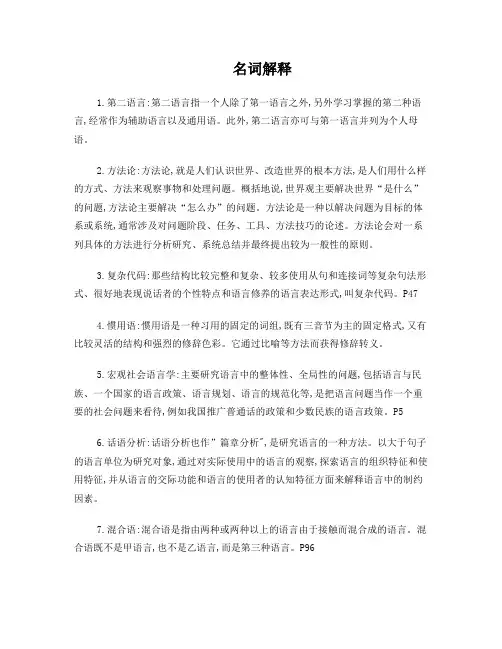
名词解释1.第二语言:第二语言指一个人除了第一语言之外,另外学习掌握的第二种语言,经常作为辅助语言以及通用语。
此外,第二语言亦可与第一语言并列为个人母语。
2.方法论:方法论,就是人们认识世界、改造世界的根本方法,是人们用什么样的方式、方法来观察事物和处理问题。
概括地说,世界观主要解决世界“是什么”的问题,方法论主要解决“怎么办”的问题。
方法论是一种以解决问题为目标的体系或系统,通常涉及对问题阶段、任务、工具、方法技巧的论述。
方法论会对一系列具体的方法进行分析研究、系统总结并最终提出较为一般性的原则。
3.复杂代码:那些结构比较完整和复杂、较多使用从句和连接词等复杂句法形式、很好地表现说话者的个性特点和语言修养的语言表达形式,叫复杂代码。
P474.惯用语:惯用语是一种习用的固定的词组,既有三音节为主的固定格式,又有比较灵活的结构和强烈的修辞色彩。
它通过比喻等方法而获得修辞转义。
5.宏观社会语言学:主要研究语言中的整体性、全局性的问题,包括语言与民族、一个国家的语言政策、语言规划、语言的规范化等,是把语言问题当作一个重要的社会问题来看待,例如我国推广普通话的政策和少数民族的语言政策。
P56.话语分析:话语分析也作”篇章分析",是研究语言的一种方法。
以大于句子的语言单位为研究对象,通过对实际使用中的语言的观察,探索语言的组织特征和使用特征,并从语言的交际功能和语言的使用者的认知特征方面来解释语言中的制约因素。
7.混合语:混合语是指由两种或两种以上的语言由于接触而混合成的语言。
混合语既不是甲语言,也不是乙语言,而是第三种语言。
P968.借词:借词就是借用其他民族语言中词语的形式而产生的次,又称外来词汇。
P1299.禁忌:禁忌语也是语言魔力的一种表现形式。
P153禁忌语指人们在说话时,由于某种原因,不能、不敢或不愿说出某些具有不愉快的联想色彩的词语。
而以之代替的词语。
10.局限代码:英国社会学家伯恩斯坦把那些结构简单、大量使用人称代词和附加问句、句法选择比较易于“预测”(较为普通,缺少个性)的语言表达方式,叫局限代码。
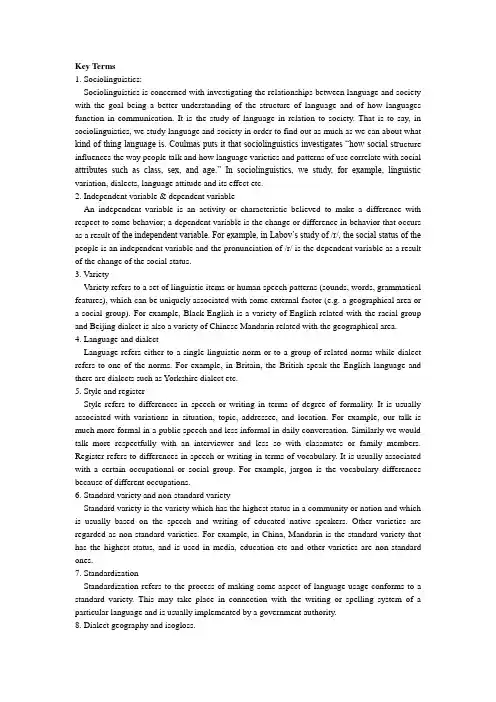
Key Terms1. Sociolinguistics:Sociolinguistics is concerned with investigating the relationships between language and society with the goal being a better understanding of the structure of language and of how languages function in communication. It is the study of language in relation to society. That is to say, in sociolinguistics, we study language and society in order to find out as much as we can about what kind of thing language is. Coulmas puts it that sociolinguistics investigates “how social str ucture influences the way people talk and how language varieties and patterns of use correlate with social attributes such as class, sex, and age.” In sociolinguistics, we study, for example, linguistic variation, dialects, language attitude and its effect etc.2. Independent variable & dependent variableAn independent variable is an activity or characteristic believed to make a difference with respect to some behavior; a dependent variable is the change or difference in behavior that occurs as a result of the independent variable. For example, in Labov’s study of /r/, the social status of the people is an independent variable and the pronunciation of /r/ is the dependent variable as a result of the change of the social status.3. VarietyVariety refers to a set of linguistic items or human speech patterns (sounds, words, grammatical features), which can be uniquely associated with some external factor (e.g. a geographical area or a social group). For example, Black English is a variety of English related with the racial group and Beijing dialect is also a variety of Chinese Mandarin related with the geographical area.4. Language and dialectLanguage refers either to a single linguistic norm or to a group of related norms while dialect refers to one of the norms. For example, in Britain, the British speak the English language and there are dialects such as Yorkshire dialect etc.5. Style and registerStyle refers to differences in speech or writing in terms of degree of formality. It is usually associated with variations in situation, topic, addressee, and location. For example, our talk is much more formal in a public speech and less informal in daily conversation. Similarly we would talk more respectfully with an interviewer and less so with classmates or family members. Register refers to differences in speech or writing in terms of vocabulary. It is usually associated with a certain occupational or social group. For example, jargon is the vocabulary differences because of different occupations.6. Standard variety and non-standard varietyStandard variety is the variety which has the highest status in a community or nation and which is usually based on the speech and writing of educated native speakers. Other varieties are regarded as non-standard varieties. For example, in China, Mandarin is the standard variety that has the highest status, and is used in media, education etc and other varieties are non-standard ones.7. StandardizationStandardization refers to the process of making some aspect of language usage conforms to a standard variety. This may take place in connection with the writing or spelling system of a particular language and is usually implemented by a government authority.8. Dialect geography and isogloss.Dialect geography refers to the study of geographic distribution of linguistic items, the results plotted on maps (dialect atlases). Lines marking the boundaries of linguistic features on such maps are isoglosses. For example, in the following map which shows the distribution of /r/, /u/ and // pronunciation, the lines, both dotted and real lines are called isogloss./r/-full &/ //r/-less & / / /r/-full & /u//r/-less &/u/9. NetworksNetworks refer to groups of people who communicate with each other regularly. The density of a social network depends on the degree to which the people who form the social network all know each other.The concept “networks” is used to view how an individual relates to oth er individuals in society. That is, it studies how and on what occasions a specific individual A interacts now with B, then with C, and then again with D, how intensive the various relationships are, (does A interact more frequently with B than with C or D?) and how extensive A’s relationship with B is in the sense of how many other individuals interact with both A and B in whatever activity brings them together. People can be involved in a dense network if the people you know and interact with also know and interact with one another. If they do not, the network is a loose one. And people are said to be involved in a multiplex network if the people within it are tied together in more than one way.10. VariationVariation refers to language differences in speech and writing between speakers of different ages, genders, social classes or identities; or differences in differences in different situation, topic, addressee, and location; including difference over time. For example, to refer to the same automotive vehicle suitable for hauling, Americans and British would use different words: truck v.s. lorry, and spell the same word meaning the middle as something as “centre” v.s. “center”.11. Speech repertoireSpeech repertoire refers to the range of linguistic varieties which the speaker has at his disposal and which he may appropriately use as a member of his speech community. It can be used to describe the communicative competence of individual speakers. Each person will then have a distinctive speech repertoire. And quite often , many individuals will have virtually identical repertoire.12. IdiolectIdiolect refers to the speech characteristics and linguistic behavior of individuals.13. Lingua francaLingua franca refers to a language which is used habitually by people whose mother tongues are different in order to facilitate communication between them. It can be spoken in a variety of ways. For example, today English is used in very many places and for very many purposes as a lingua franca, e.g., in travel and often in trade, commerce, and international relation. And the English can serve as a lingua franca in many parts of the world, and for some speakers, it is a native language, and still others a foreign language.14. Speech communitySpeech community has been defined differently by different people. But generally it can be used to refer to a group of people who form a community, e.g. a village, a region, a nation, and who have at least one linguistic variety in common. Possible standards for defining a speech community are one single speech variety, shared attitudes towards linguistic behavior in the community, and in-group social cohesiveness.15. PidginPidgin refers to a linguistic variety which develops as a contact language when groups of people with different mother tongues come into contact and communicate with one another, as when foreign traders communicate with the local population or workers on plantations or in factories communicate with one another or with their bosses. It i s no one’s first language. For example, Tok Pisin is used as a unifying language among speakers of many different languages in Papua New Guinea.Characteristics of pidgin: simplifications of pronunciation, vocabulary, and grammar16. CreoleCreole refer s to a “pidgin” which has become the native language of a group of speakers, being used for all or many of their daily communicative needs.Characteristics of Creole when compared with pidgins: larger vocabulary; more complex grammar; more styles.17. CodeCode is a term used instead of language, speech variety, or dialect. It is sometimes considered to be a more neutral term than the others.18. DiglossiaDiglossia refers to a situation in which two very different codes exist side by side in a speech community, each with a distinct range of social functions. The key defining characteristic of diglossia is that the two varieties are kept quite apart in their functions. The High variety (or H-variety) is usually more standardized, and is used in government, the media, education, and for religious services; the Low-variety (or L-variety) is used in family conversation and other relatively informal setting. For example, in Switzerland, there are Standard German (H) and Swiss German (L) varieties, with the former one used in most of the formal situations, and the latter for other informal settings. And in Haiti, there are Standard French (H) and Haitian Creole (L).19. BilingualismBilingualism can refer to the community where two languages are used, and the ability to use tow languages either by an individual or by a speech community. Balanced, compound, and coordinate bilingualism20. Code-switchingCode-switching refers to a change by a speaker (or writer) from one code to another. It is a conversational strategy used to establish, cross or destroy group boundaries, to create, evoke or change interpersonal relations with their rights and obligations. For example, to hide meaning from a third party present at the conversation, the two speakers may switch to their hometown dialect to distance their relation.21. code-mixingCode-mixing is the mixed use of codes. Usually the two codes involved are not of equal position with one being predominant and the other subordinate. For example, “明天是peter的part,我们开一个party,好吗?”22. Implicational scaleImplicational scale is a term from variation theory particularly associated with the study of the post-creole continuum. It is introduced by the American linguist David DeCamp in 1971 as a way of showing relationships between linguistic varieties. He demonstrated that certain linguistic forms from the Jamaican social dialect continuum had both creole and standard variants. There variants can be ranked in terms of their “creoleness” and “standardness” on an implicatio nal hierarchy that is observed by (nearly all) speakers, such that usage by a speaker of creole forms from a particular point on the hierarchy implies that one can predict that he or she will also use creole forms from lower down on the hierarchy, but not necessarily from higher up. That is, some mesolectal forms are more basilectal or acrolectal than others. Similarly, use of standard forms from a particular point on the continuum also implies use of standard forms from higher up on the hierarchy, but not necessarily use of those from lower down.23. CultureCulture is the sum total of all contributions of a group of people, in a designated area, within a given time. It represents, more specifically, the aesthetic or intellectual achievement or appreciation of an individual or a society, and also the lifestyle of a society as passed on from generation to generation.24. Whorfian hypothesisWhorfian hypothesis has two versions: strong one and weak one.The strong version says that one’s thinking is c ompletely determined by his native language because one cannot but perceive the world in terms of the categories and distinctions encoded in the language.The categories and distinctions encoded in one language system are unique to that system and incommsurable with those of other systems.The weak version puts it that the structure does not determine the world-view but is still extremely influential in predisposing speakers of a language toward adopting a particular world-view.25. Prototype theoryA prototype is the first model that is made of something new, first or original example, e.g. an aircraft, from which others have been or will be copied or developed.Prototype theory refers to the idea that concepts are best viewed as prototypes. A prototype-based concept can be learned on the basis of a very small number of instances, perhaps a single one, and without any kind of formal definition.26. EthnographyEthnography is a non-manipulative study of the cultural characteristics of a group in real world rather than laboratory setting, utilizing ethnographic techniques and providing a socio-cultural interpretation of the research data. For example, an ethnography of a communicative event is a description of all the factors that are relevant in understanding how that event achieves its objective. And Lindenfeld’s ethnographical study offers an account of the language of a dozen long-standing urban marketplaces in Paris etc, the talk of vendors, vendor-customer talk, politeness routines, small talk, jokes, insults, etc. An alternative approach to devising ethnographies is to attempt to describe the different functions of language in communication. 27. EthnomethodologyEthnomethodology is the study of how individuals create and understand their daily lives. Subjects for such studies are not people in primitive tribes, but those in contemporary society. It is a branch of sociology, which ahs links with conversation analysis because of its use of recorded conversation material as data. Most ethnomethodologists study not language or speech, but talk. In particular, they are interested in what is not said. They focus on the shared common-sense knowledge speakers have of their society which they can leave unstated in conversation because it is taken fro granted by all participants.28. Communicative competenceCommunicative competence refers to the ability not only to apply the grammatical rules of a language in order to form grammatically correct sentence, but also to know when and where to use these sentences and to whom. CC refers to whether (and to what degree) something is formally possible, feasible, appropriate, and in fact done. It includes linguistic competence; sociolinguistic competence, discourse competence, and strategic competence.29. Speech actsUtterances as functional units in communication30. Turn-takingTurn-taking refers to the distribution of talk across participants in conversation. There are there ways of turn-taking (degree of control). Firstly, turn-taking happens by mentioning his/her name, current speaker selects the next speaker. Secondly, by asking a question, current speaker invites another speaker to speak but leaves the choice open. Thirdly, a certain hearer self-selects as the next speaker.31. Adjacency pairsIt refers to sequences of two utterances that are adjacent, produced by different speakers, ordered as a first part and a second part, typed so that a particular first part requires a particular second part or range of second parts. For example, a question can lead to an answer, which can lead to a comment, which can lead to an acknowledgment, and so on.32. SolidarityIt refers to support and unity resulting from common interests or feelings in communication, and feelings of shared experience and common group membership.33. PolitenessIt refers to recognition of other’s rights in a social situation. (positive and negative politeness by Penelope Brown and Stephen Levinson)34. Address termsAddress terms refer to second-person pronouns, or names, or titles, or endearments, and expressions used when speaking to someone. For example, the same person may be addressed by “you”, “Mr. James Martin”, “Professor Martin”, “dear”, or other expression.35. Language planning“Language planning is a government a uthorized, long-term, sustained and conscious effort to alter a language’s function in a society for the purpose of solving communication problems” (Weinsten, 1980). It refers to deliberate efforts to influence the behavior of others with respect to the acquisition, structure, or functional allocation of language. Typically it will involve the development of goals, objectives and strategies to change the way language is used. At a governmental level, language planning takes the form of language policy. Many nations have language regulatory bodies which are specifically charged with formulating and implementinglanguage planning policies.36. Status planningIt refers to deliberate efforts to allocate the functions of languages and literacies within a speech community. It involves status choices, making a particular language or variety an “official language”, “national language”, etc. Often it will involve elevating a language or dialect into a prestige variety, which may be at the expense of competing dialects. Status planning is often part and parcel of creating a new writing system. Status planning tends to be the most controversial aspect of language planning.37. Corpus planningIt refers to prescriptive intervention in the forms of a language. This may be achieved by creating new words or expressions, modifying old ones, or selecting among alternative forms. Corpus planning aims to develop the resources of a language so that it becomes an appropriate medium of communication for modern topics and forms of discourse, equipped with the terminology needed fro use in administration, education, etc. Corpus planning is often related to the standardization of a language, involving the preparation of a normative orthography, grammar, and dictionary for the guidance of writers, and speakers in a speech community. Efforts at linguistic purism and the exclusion of foreign words also belong the courpus planning, as do spelling reform and the introduction of new writing system.38. Linguistic assimilation and linguistic pluralismLinguistic assimilation is the belief that everyone, regardless of origin, should learn the dominant language of the society. (France example) Linguistic pluralism is the recognition of more than one language. It can be territorially based or individually based or there may be some combination of the two. It can be complete or partial, so that all or only some aspects of life can be conducted in more than one language in a society. (Canada)39. Vernacularizaion and internationalismVernacularization is the restoration or elaboration of an indigenous language and its adoption as an official language, e.g., Bahasa Indonesia in Indonesia.Internationalism is the adoption of a non-indigenous language of wider communication either as an official language or for such purposes as education or trade, e.g., English in Singapore, India, the Philipines, and Papua New Guinea.1.What is the scope of sociolinguistic research?The scope of sociolinguistic includes linguistic situation; dialects; language in communication; language attitude and its effect; language contact and language change; language planning and language standardization.2.What insights can we get from sociolinguistic?①Language is not a close and abstract system, and it is a social interaction and a conduct of communication.②Linguistic competence includes knowledge of language and knowledge of language use.③Linguistic variation and language change are closely related to the social context.3.What are the major approaches in sociolinguistic?①Linguistic sociolinguistic②Ethno-sociolinguistic③The sociology of language④The social psychology of language⑤Pragmatic sociolinguistic4.What is the interactional sociolinguistic research method?Research methods in IS involve several stages:① A preliminary period of ethnography②The main process of data collection, transcription and analysis③ A final effort of confirming the findings as consonant with current knowledge. Question 5. Please compare linguistics and sociolinguisticsLinguistics can be defined as a scientific study of language. The scope of linguistics includes at least five branches, namely, phonologic, morphologic, syntactic, semantic and pragmatic.Sociolinguistics is a kind of macro-linguistics, which shows an interdisciplinary nature between linguistics and sociology. The scope of sociolinguistic includes linguistic situation; dialects; language in communication; language attitude and its effect; language contact and language change; language planning and language standardization.6.Please compare dialectology and sociolinguistics.The study of language in society is called sociolinguistics. The real basis for much of sociolinguistics is that the differences in language among members of a speech community or between different regions speaking different varieties of the same language are often meaningful for society. Not everyone who speaks a given language speaks it in the same way. An individual's particular way of speaking is called an idiolect. Language variants spoken by entire groups of people are referred to as dialects. Dialectology is a branch of sociolinguistics that studies the systematic variants of a language. The term dialect was first coined in 1577 from the Latin dialectus, way of speaking. Dialectal variation is present in most language areas and often has important social implications.But dialectology and sociolinguistics have many differences as well:(1)Dialectology focuses on the pronunciation of the dialects, aiming at summarizing thephonology, but sociolinguistics does not necessarily do so, focusing on the linguistic variations, that is, the differences because of different statuses, different ages and different situations.(2)Both dialectologists and sociolinguists use the on-the-spot research method, but the formerwill regard the one-person-from-one-place as the standard, that is, the informant should be strictly selected without considering the aspects like age, gender, social class and so on. But the latter focuses on the different social strata and random sampling from more people and then proceed with the quantitative analysis to reach the linguistic rules.(3)Dialectologists indulge in the researches on the rural dialects and the dialects of old people,trying to find the rules of language slow changes; but sociolinguists more venture into the cities, because in cities there are more social classes, more linguistic phenomena.7. Explain the Sapir-Whorf Hypothesis in your own words and give your comments.Explain:讲义答案:(1)One’s thinking is completely determined by his native language because one cannot butperceive the world in terms of the categories and distinctions encoded in the language.(2)The categories and distinctions encoded in one language system are unique to that system andincommensurable with those of other systems.strong version:The Sapir-Whorf hypothesis makes the claim that the structure of the language one habitually uses influences the manner in which one thinks and behaves.weak version:The structure does not determine the world-view but is still extremely influential in predisposing speakers of a language toward adopting a particular world-view. Comment:The strong version goes to extremes but the weak version is acceptable. Different languages may refer to certain characteristics of the real world in terms of different sub-set of characteristics. However, speakers of both languages may still be aware of all the characteristics. The way a given language encodes experience semantically makes aspects of that experience not exclusively accessible, but just more salient for the users of that language. It’s absurd to say speakers of one language cannot have access to modern scientific thought because their language doesn’t allow them to.8. Do taboo and e uphemism serve any socially useful purpose? Or are they just ‘relics of the Dark Ages’ ?Taboo and euphemism do serve some socially useful purpose.Taboo is the prohibition or avoidance in any society of behavior believed to be harmful to its members in that it would cause them anxiety, embarrassment, or shame.Standards and norms change, linguistic taboos are also violated on occasion to draw attention to oneself, or to show contempt, or to be aggressive or provocative, or to mock authority, such as “damn it”, “shit” “you bastard”, “you son of bitch”, etc.Euphemism defined as “a good interpretation of a bad word” can mainly serve five functions: avoidance of taboo, avoidance of vulgarity, politeness, deception and satire.1.Avoidance of taboo: People’s fear of death generates many euphemisms for death, such as “go Heaven/ Paradise”, “be at peace”, “return to dust/ earth”.2.Avoidance of vulgarity: we use “go to the bathroom”, “wash hands”, “go to the powder room”for “go the toilet”.3.Politeness: we use “senior citizens”, “seasoned”, “well-preserved” for “old”.4. Deception:Governments often use substandard housing (次标准房) for slum(贫民区);revenue enhancement (税收加强) for tax increase (增税)5. Satire: “live on nothing”, original ly from Vanity Fair by William Thackeray, is used as aneuphemism to satirize those stingy misers.9. What difficulty do you encounter in discussing address terms with English speaking people? Do you ever experience difficulty because your terms and theirs fail to match? And what kind of terms do you use?Chinese address system is more complex than English address system. Therefore when discussing address terms with English speaking people, Chinese people may find many terms difficult to explain.1). Usage of kinship terms. Chinese kinship system includes a variety of address terms, which have no direct equivalents in English. For example, “aunt” means “舅母”, “姑姑”, “姨娘”, “婶婶”, etc. in Chinese.2). Some Chinese terms have different meanings in different occ asions. For example, “大爷”. If you ask a rather old man for the way to some place, it is just a appellation. It can also be used to address your father’s elder brother. In the old society, it is used to address those rich males or officers, landlords.3). Chinese people favor the use of post and rank titles, but there are not enough titles matching Chinese titles in English, for example, “科长”, “4). Some unique address terms of Chinese characteristics, such as “同志”, “小”, “老”. Take “叶老” as an example. “叶老” is a respectful address term to “叶圣陶”, but we can hardly find a counterpart of “老” in English.举例说明不能匹配的称谓语,如“司令”,“排长”—直接用Mr. 表示头衔“孩子他妈"—my wife “二姑奶”—my grandpa’s second sister. In order to explain those kinship terms, we have use more words to describe the relationship.10. Define the distinction of tu and vous at work in conversation?From the pronominal choice between tu and vous forms in languages, we can see that certain linguistic choices a speaker makes indicate the social relationship that the speaker perceives to exist between him or her and the listener or listeners. Many languages have a distinction corresponding to the tu-vous (T/V) distinction in French, where grammatically there is a ‘singular you’ tu (T) and a ‘plural you’ vous (V) but the usage requires that you use vous with individuals on certain occasions. The T form is sometimes described as the ‘familiar’ form and the V form as the ‘polite’ one.The asymmetrical T/V usage such as the upper class addressed the lower classes with T but received V symbolizes a power relationship. Symmetrical V usage is ‘polite’ usage. Symmetrical T usage is to show intimacy and its use for that purpose also spread to situations in which two people agreed they had strong common interests, i.e., a feeling of solidarity, this mutual T for solidarity gradually came to replace the mutual V of politeness, since solidarity is often more important than politeness in personal relationships. Moreover, the use of asymmetrical T/V to express power decreased and mutual V was often used in its place, as between officer and soldier. Today, we can still find asymmetrical T/V uses, but solidarity has tended to replace power, so that now mutual T is found quite often in relationships which previously had asymmetrical usage, e.g., father and son, employer and employee. Tu should be used between spouses, between brothers and sisters regardless of age, between parents and children, between close relatives, between young people living or working closely together, and between adults who have a friendship of long-standing. Vous should be used between strangers, between those who have no ties of any kind, and between inferior and superior. Nowadays power is no longer as important as it once was in determining T/V usage; there has been a dramatic shift in recent years to solidarity.Different societies devise different ways of handling the T/V distinction e.g., T/V forms being differently employed in Germany, France, and Italy. English has no active T/V distinction. T/V usage is constantly involving. The evolution is not always toward solidarity and away from power. Power is still very much part of modern social structure.。
社会语言学教程期末复习材料第一章1.“社会语言学”这一学科名称,是由“社会学”和“语言学”复合而成的。
其基本内容包括两个方面:1)一是社会语言学,其基本涵义是:从语言的社会属性出发,用社会学的方法研究语言,从社会的角度解释语言变体和语言演变。
2)二是语言社会学,其基本涵义是:从语言变体和语言演变的事实,来解释相关的社会现象及其演变和发展的过程。
3)两者的研究方向不同,简而言之,前者从社会研究语言,后者从语言研究社会。
2.社会语言学的三位先锋:拉波夫、特鲁杰和海姆斯。
3.着重调查研究不同阶层、不同年龄、不同场合的语言差异,即语言变项。
4.《纽约市百货公司(r)的社会分层》P105.特鲁杰的方言调查P11这个世界在亚马逊河的西北部地区。
该地区一半在巴西境内,一半在哥伦比亚。
它地广人稀,面积相当于英格兰,而人口只有1万左右。
居民大多数是土著印第安人,分为20多个部落,这些部落又组成了5个部落群。
每个部落都说不同的语言——不同到相互之间无法理解的程度,也非源于同一母语。
5个部落群实行族外通婚制。
结果是一个男子的妻子肯定说一种和他不同的语言。
妻子要住在丈夫长大的地方,与子女讲话的时候必须用丈夫的语言(“语言从夫婚姻”)。
母亲不能把自己的语言交给孩子,而是把自己只不过像外国人一样所讲的一种语言教给孩子。
孩子生活在大家庭里,跟讲父亲语言的人接触较多,他们的语言没有出现“退化”现象。
问题:1、语言确定部落;2、语言显示地位;3、在一个讲X语言的部落里,有土著语使用者,也有非土著语使用者。
如果要编写X 语言的语法,语法的适用对象究竟是谁?是所有土著语言使用者(包括散落在其他部落的妇女)?还是该部落里的所有说话者,包括土著人和非土著人?语言的接触、双语现象、语码的选择等。
一个部落里会有不同语言,对语言的选择往往根据需要而定(与子女讲话的时候必须用丈夫的语言这点除外)。
要是来了客人不懂X部落的语言,而部落中有人懂客人的语言,那么,主人在跟客人讲话的时候,就会使用客人的语言。
语言学纲要复习重点导言:1、语言学:以语言作为研究对象的一门独立科学。
任务:研究语言的结构规律和演变规律。
结构规律:技巧:语音、词汇、语法规则。
(语言三要素)2、小学:指我国传统的语文学,包括文字学、音韵学、训诂学三方面的内容。
3、共时语言学:以某种具体的语言为研究对象,从一个横断面描写研究语言在某一个时期的状态的语言学,如现代汉语。
由于它是以一个静止的时段的角度观察和研究语言,因而称为共时语言学。
4、历时语言学:以某种具体的语言为研究对象,从一个纵的方面研究语言发展的历史,观察其演变的轨迹的语言学,如汉语史、英语史。
由于它从一个较长的时段研究语言的发展动态,因此称之为历时语言学。
5、语言学的几个流派:历史比较语言学(索绪尔[瑞典]《普通语言学教程》)、美国描写语言学派(布龙菲尔德)、转换——生成学派(乔姆斯基)、系统——功能学派、结构语言学派、社会语言学派、布拉格学派、哥本哈根学派。
6、古罗马——希腊、古印度、中国是语言学的三大发源地。
7、普通语言学:以人类一般语言为研究对象,研究人类语言的性质、结构特征、发展规律,是综合众多语言的研究成果而建立起来的语言学,是语言学的重要理论部分。
8、古代的语言研究和今天的语言研究有哪些不同?①研究对象不同:古代的语言学以书面语为主要研究材料,不重视口头语言的研究;而今天的语言学则十分重视口语研究,如制定语言规范,确立共同语的各方面标准等,都要依据口语的研究成果。
②研究目的不同:古代语言学研究语言,主要是给政治、哲学、宗教、历史、文学方面的经典著作作注解,比如我国古代的语文学主要就是围绕阅读先秦经典著作的需要来研究文言的;而现代语言学的研究目的主要是分析语言的结构,以此探讨语言发展的共同规律。
③研究方法不同:古代的语言学没有确切的语言研究方法;而现代语言学有自己独立的研究方法——历史比较法。
④是否独立学科:古代的语言学不是独立学科;而现代语言学因为有了历史比较法,成为了一门独立的学科。
《语言学概论》复习要点重点名词概念:语言学、普通语言学、专语语言学、共时语言学、历时语言学一、语言学、语言学的对象和任务二、语言学在科学体系中的地位三、语言学的基本类别根据研究的对象的不同,语言学分为共时语言学和历时语言学、专语语言学和普通语言学。
四、语言学流派各个语言学流派的观点、代表人物有所了解即可,注意布拉格学派、哥本哈根学派以及美国结构语言学派(也称美国描写语言学)都属于结构主义学派,是这一学派的三个分支。
关于语言学流派的具体内容阐述,不作考试要求。
第一章言语的社会功能本章须明确两个大的要点:语言的社会功能,即交际工具和思维工具;语言是一种社会现象。
主要名词概念:语言、社会、社会现象第一节语言是人类最重要的交际工具一、语言是人类社会的交际工具1.语言的交际功能:语言是人类区别于其它动物的一个重要标志。
语言是联系社会成员的桥梁和纽带,是社会成员互相之间交际和交流思想的工具,也是协调社会成员行动一致的工具。
2.语言是一种社会现象:语言是一种社会现象,和人类社会有着十分紧密的联系,没有人类社会,就没有语言,人类社会以外的社会无所谓语言。
所谓社会现象是指那些与人类共同体的产生、存在和发展等活动密切联系的现象。
不同的民族有不同的语言,不同的地域有不同的语言,同时社会的变化也给语言以极大的影响,而离开了人类社会,就无所谓语言可言了。
总之,语言就是一种社会现象,同社会的关系非常密切,其产生、发展等都要受到社会的影响。
语言不是自然现象,一方面,语言同社会有着十分紧密的联系,社会的发展变化直接影响着语言的发展变化,也就是说,语言的发展变化是受制于社会的;另一方面,从语言的音义联系看语言不是自然现象,而是社会约定俗成的,没有必然的本质的联系,如果语言是自然现象,世界上的语言应该一样的,没有区别的,而实际上世界上的语言多种多样,而且许多语言中还有方言,这说明语言决不是自然现象。
3.语言是一种特殊的社会现象:语言不但是社会现象,而且是一种特殊的社会现象。
社会语言学题目1.中国印度古希腊-罗马具有悠久的历史文化传统,是语言的三大发源地。
2.文字学音韵学训诂学是我国传统的语文学。
3.研究语言的结构,主要是研究语音词汇和语义语法三个部分。
4.运用语言传递信息的过程,可分为编码发送传递接收解码五个过程5.专语语言学可以从纵向和横向研究语言,由于研究角度不同,所以又分为历时语言学和共时语言学6.历史比较语言学的建立,标志着语言学开始走上独立发展的道路。
7.布隆菲尔德的代表著作《语言论》,是美国结构主义语言学的奠基性著作。
8.索绪尔被称为现代语言之父,其代表作有《普通语言学教程》1.人和动物的区别是人会制造工具,而且人类有语言这是人类和动物相区别的重要标志之一。
2.一种语言中的句子的数量是无限的,人类之所以能掌握语言,是因为构成句子的语言材料和组织语言材料的规则是十分有限的。
3.语言是人类社会最重要的交际工具,而且也是思维的最重要最有意义的工具。
4.汉民族点头表示肯定摇头表示否定送别时挥手表示再见,鼓掌表示欢迎,咬牙切齿表示愤怒,手舞足蹈表示兴奋。
5.人的大脑分左右两半球,大脑的左半球控制语言活动,右半球掌管不需要语言的感性直观思维6.汉语的姐姐、妹妹用英语表示sister 汉语的叔叔、姑父等,英语用uncle。
7.英语可以直接用数词修饰名词,汉语数词修饰名词一般要加上量词。
8. 儿童最早的智力活动就是学习语言9.语言是特殊的社会现象的含义是语言具有全民性没有阶级性10.语言和说话的关系可以这样理解:语言是社会的、全民共有的,说话是个人的;语言是抽象的,说话是具体的。
1.语言最主要的社会功能就是作交际工具。
(√)2.文字是辅助语言交际的工具,对语言交际起辅助作用。
(×)3.语言没有阶级性,一视同仁地为社会全体成员服务,这里的共同语言,是指阶级观念、思想感情,不是作为交际工具的语言。
(×)4.语言声音的发出和声波的传递具有自然属性的一面,但语言的音义结合却是社会赋予的,所以语言从本质上看是社会现象,而不是自然现象。
中国文化概论书本绪论一为什么说文化就是“自然的人化”?文化的实质性含义是指:人化或人类化,即人类主体通过社会实践活动,适应、利用、改造自然界客体而逐步实现自身价值观念的过程。
其体现即有自然面貌、形态、功能的不断改观;也有人类个体与群体素质的不断提高和完善。
二怎样理解广义文化与狭义文化的联系和区别?广义的文化,着眼于人类与一般动物,人类社会与自然界的本质区别,着眼于人类卓立于自然的独特的生存方式,其涵盖面非常广泛,所以又被称为大文化。
狭义的文化排除人类社会——历史生活中关于物质创造活动及其结果的部分,专注于精神创造活动及其结果,主要是心态文化,又称“小文化”。
三文化结构的四层次包括哪些内容?对文化的结构解剖,有两分说,即分为物质文化和精神文化;有三层次说,即分为物质、制度、精神三层次;有四层次说,即分为物质、制度、风俗习惯、思想与价值。
有六大子系统说,即物质、社会关系、精神、艺术、语言符号、风俗习惯等。
(注意:这里还是记住为好,六大系统可简记为:社语俗物精艺)四怎样认识和评价中国传统文化?中国传统文化是中华民族历史的结晶,具有历史性和现实性,不是博物馆里的陈列品,传统文化所蕴含的、代代相传的思维方式、价值观念、行为准则、一方面具有强烈的历史性、遗传性;另一方面具有鲜活的现实性、变异性,它无时无刻不在影响着今天的中国人,为我们开创新文化提供历史的根据和现实的基础。
第一章中国文化的历史地理环境一历史上哪些地理因素对中国文化的形成和发展产生过较大的影响?举例说明。
1 黄河中下游一带是是中国历史上百姓生存和繁衍的最适宜地区,在中国占主导地位的传统文化,无论是物质的,还是精神的,都是建立在农业生产的基础上的,它们形成于农业区,也随着农业区的扩大而传播。
农业文明对中国文化的延续性起了很大的作用。
2 地理环境对中国文化多样性的影响主要表现为,地理障碍对人类活动、特别是交通运输的影响。
不同的地理环境与物质条件,形成了不同人群的不同生活方式与思想观念,受到了不同程度的外来文化影响。
社会语言学题目1.中国印度古希腊-罗马具有悠久的历史文化传统,是语言的三大发源地。
2.文字学音韵学训诂学是我国传统的语文学。
3.研究语言的结构,主要是研究语音词汇和语义语法三个部分。
4.运用语言传递信息的过程,可分为编码发送传递接收解码五个过程5.专语语言学可以从纵向和横向研究语言,由于研究角度不同,所以又分为历时语言学和共时语言学6.历史比较语言学的建立,标志着语言学开始走上独立发展的道路。
7.布隆菲尔德的代表著作《语言论》,是美国结构主义语言学的奠基性著作。
8.索绪尔被称为现代语言之父,其代表作有《普通语言学教程》1.人和动物的区别是人会制造工具,而且人类有语言这是人类和动物相区别的重要标志之一。
2.一种语言中的句子的数量是无限的,人类之所以能掌握语言,是因为构成句子的语言材料和组织语言材料的规则是十分有限的。
3.语言是人类社会最重要的交际工具,而且也是思维的最重要最有意义的工具。
4.汉民族点头表示肯定摇头表示否定送别时挥手表示再见,鼓掌表示欢迎,咬牙切齿表示愤怒,手舞足蹈表示兴奋。
5.人的大脑分左右两半球,大脑的左半球控制语言活动,右半球掌管不需要语言的感性直观思维6.汉语的姐姐、妹妹用英语表示sister 汉语的叔叔、姑父等,英语用uncle。
7.英语可以直接用数词修饰名词,汉语数词修饰名词一般要加上量词。
8. 儿童最早的智力活动就是学习语言9.语言是特殊的社会现象的含义是语言具有全民性没有阶级性10.语言和说话的关系可以这样理解:语言是社会的、全民共有的,说话是个人的;语言是抽象的,说话是具体的。
1.语言最主要的社会功能就是作交际工具。
(√)2.文字是辅助语言交际的工具,对语言交际起辅助作用。
(×)3.语言没有阶级性,一视同仁地为社会全体成员服务,这里的共同语言,是指阶级观念、思想感情,不是作为交际工具的语言。
(×)4.语言声音的发出和声波的传递具有自然属性的一面,但语言的音义结合却是社会赋予的,所以语言从本质上看是社会现象,而不是自然现象。
(×)5.语言不同于一般的社会现象,因为社会现象都是属于一定是上层建筑和经济基础的,而语言既不属于上层建筑又不属于经济基础。
(√)6.语言的确是通过个人的运用体现出来的,但语言并不是个人现象,因为语言是社会全体成员共同创造的,没有社会,个人不可能创造出语言来,所以语言是社会现象。
(× )7.在现代社会,文字使用非常广泛,日益重要,但无论文字有多重要,都只是辅助语言进行交际的工具,记录语言的工具,离不开语言这个基础,所以不可能取代语言,没有语言,文字的存在就失去了意义。
(×)8.现代社会沟通的方式很多,只是说明运用语言的方式多了,不像过去只能当面交际或通过文字交际,可以采用其它方式,但这种种沟通方式都是以语言为基础的,离不开语言,这只能说明语言是非常重要的(×)9.人类社会须臾也不能离开语言,没有语言,人类无法沟通,社会就会崩溃,人类社会就不复存在了。
(√)10.动物没有人类意义上的语言,人类语言具有社会性,是要通过与社会接触才能学会的,而动物的鸣叫等是先天遗传的,不是语言。
(√)11.人类的思维可以分几种,而要进行抽象思维,就离不开语言这个工具,没有语言,人类就只能进行比较低级的思维活动.( √)12.人类要进行抽象思维,必须借助于语言中的词语句子进行分析综合推理.( ×)13.语言和思维是相互依存,共同发展的。
语言是思维的工具,又是思维的成果,思维离不开语言,同时语言也离不开思维。
二者如影随形,谁也离不开谁。
语言和思维是密了可分的,各以对方为存在条件,所以语言和思维的相辅相成的。
思维必须在语言材料的基础上进行,哪里有思维活动,哪里就有语言活动.( √)14.二者如影随形,谁也离不开谁。
没有语言,思维活动无法进行,思维成果无法表达,思维实际上就不可能存在;语言作为思维的工具,只有具有思维活动,只有在思维过程中运用才有存在的意义,如果没有思维活动,无所谓交际和思想,语言工具也就失去了存在的价值,没有必要存在了。
(√)15语言和思维不是同一个东西,二者没有同一性。
语言既然是思维的工具,就不会是思维本身。
(×)16.语言既然是人类的交际工具,所以无论它是在无阶级的社会还是有阶级的社会,都不可能具有阶级性,否则,语言就不会成为社会全体成员的交际工具了。
(√)17.语言其实是一个抽象的概念,它反映的是人类语言所具有的共同特指,所谓“语言”是不存在的,都是通过个别的具体的语言体现出来,如英语、汉语、日语、俄语等等。
语言是概括的、一般的,和具体的语言是一般和特殊的关系,通过特殊的语言表现出来。
(√)18马是一个抽象的概念,反映了世界上所有马匹的共同特征,我们在现实生活中所说的马,都是具体的,如白马、大马、母马等。
(√)19.绘画和音乐不具有符号的一般特点,其解释可能因人而异,不是语言符号。
(×)20.语言和思维是互相适应的,思维发展水平有多高,语言的发展水平就有多高。
我们不能想象,一个民族的语言十分发达,而思维水平却很低;我们同样不能想象,一个民族的思维水平很高,而语言水平很低。
这两种情况都是不可想象的,因为二者必须互相适应。
一种语言,无论它的结构简单复杂与否,都是能满足一个社会集团交际的需要的,当然也能适应思维的要求。
(√)1.任何符号,都是由形式和意义两个方面构成的。
2.一个而符号,如果没有意义就失去了存在的必要,如果没有形式,我们就无法感知,符号也就失去了存在的物质基础。
3.语言符号是语音和意义的统一体,声音是语言符号的物质形式。
4.用什么样的语音形式代表什么样的意义,完全是由使用这种语言的社会成员约定俗成。
5.语言符号具有任意性和线条性特点。
6.语言的底层是一套音位,上层是符号和符号的序列,可以分为若干级,第一级是语素,第二级是词,第三级是由词构成的句子。
7.语言系统中的所有符号,既可以同别的符号组合,又可以被别的符号所替换,符号之间这两种关系是组合关系和聚合关系。
8.组合关系是指构成线性序列的语言成分之间的结构关系,聚合关系是指在线性序列的同一结构位置上不同结构单位的替换规则。
9.人类之所以具有语言而动物没有,是因为人类具有抽象思维能力和发音的能力。
1.音素是从自然属性角度划分出来的最小的语音单位.2.国际音标是以拉丁字母为基础构成的,通常把它放在方扩号中,与一般字母区别开来.3.从物理属性角度看,语音具有音高音重音长音质四个要素,汉语的声调,就是由于音高的变化形成的.4.人类发音器官分动力发音体共鸣腔三大部分, 共鸣腔部分主要作用是调节气流,许多不同的音素,就是这一部分的变化形成的.5.音素分元音和辅音两大类,其区别的根本点是发音时气流在口腔中是否受阻 .6.元音的音质是由舌位前后舌位高低圆展与否三个方面决定的,例如“A”是舌面央低不圆唇音.7.辅音的发音特征是由发音部位发音方法决定的.例如”P”是双唇不送气清塞音.8.具体语言中具有区别词的语音形式的作用的最小语音单位就是音位.9.音位变体可分自由变体条件变体两类.例如汉语某些方言中,声母”l”可以无条件地换成”n”这两个音位是自由变体 .10.汉语音节可分声母韵母声调三部分,其中韵母又可分韵头韵腹韵尾.11.”四呼”是指开口呼齐齿呼合口呼撮口呼12.人们在说话的时候,常常把豆腐说成touf,这种音变现象叫做语流音变 .1.音位从社会属性角度划分出来的最小语音单位.2.2.音素i和y的差别是由音质的差别形成的.3.3.[p][t][k]都是塞音 .4.4. [p’][t’][k’]三个音素的区别是发音部位不同.5.5.口腔中最为灵活的发音器官是舌 .6.6.元音和辅音最本质的区别是气流是否受阻 .7.7.元音[o]具有下列发音特征中的圆唇高元音 .8.8.汉语普通话语音系统中没有发音部位齿间 .9.9.与国际音标[X]相对应的汉语音素是h .10.10.按”四呼”来给汉语音节中的韵母归类, ong属于合口呼 .11.12.1.×(音素不具备有区别词形的作用,音位具有区别词形的作用。
)13.2.×(国际音标有的使用合体字母,而不是双字母,例如æ、œ等。
)14.3.×(元音的音质由三个方面决定,舌位高低只是其中一个方面。
)15.4.×(声母和韵母是汉语语音学的分类,不是普通语音学的分类。
)16.5.×(还有圆唇与否的区别。
)17.6.×(它们是同一音位的条件变体。
)18.7.√19.8.×([g]表示的不是汉语拼音中的g,是浊塞音,普通话语音系统中没有浊塞音。
)20.9.√21.10.√22.23.1.语法规则是大家说话的时候必须遵守的习惯,不是语言学家规定的.24.2.语法的组合规则和聚合规则构成一种语言的语法规则25.3.从形式上看,句子的最大特点是具有完整的语调26.4.句子里根据表达的需要临时做出组合的词组叫做自由词组27.5.从意义和作用看,词可以分为实词和虚词两大类。
28.6.语法研究通常以词为界,词以上的规则叫句法,词以下的规则叫词法29.7.我们可以根据语素在词中的不同作用把它分成三类,例如:happinesses ,es是词尾,ness是词缀,happy是词根30.8.根据语素在词中的不同作用,一般把词根和词缀叫做构词语素,把词尾叫做变词语素。
31.9.词的组合有五种类型,例如“研究问题”是述宾结构,“跑得很快”是述补结构,“火速准备”是偏正结构,“我们努力”是主谓结构32.10.孤立语的主要特点是缺乏词形变化,屈折语的主要特点是有丰富的词形变化。
33.34.四,分析题35.1.分析下列合成词的构造方式36.地震(陈述式) 看见(补充式) 忘记(并列式)37.司令(支配式) 拖鞋(偏正式) 伤心(支配式)38.2. 用层次分析法分析下面句子的句法结构层次及关系39.轻的我们意气风发地走进不同凡响的新时代40.|主‖谓|41.|偏‖正‖偏‖正|42.|述‖宾|43.|述‖补‖偏‖正|44.|偏‖正|45.3.用变换分析方法区分下列句法多义的句子46.①我们支持的是党委王书记.(王书记是受事)47.②支持我们的是党委王书记.(王书记是施事)48.(这个句子的多义是因为"王书记"的施事还是受事身份不能确定,他可以是"支持"这一动作的发出者,也可以是"支持"这一动作的涉及对象,两种含义在这里都江得通,造成了多义.因此可以在前后适当增加成分,明确"王书记"是施事或受事,而不会既是施事又是受事.)49.50.1.基本词汇具有(全民常用)、(稳固)、(有构词能力)三个特点。